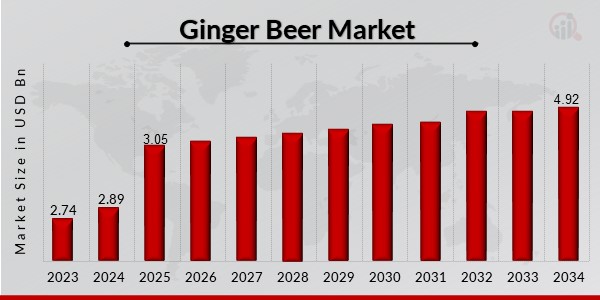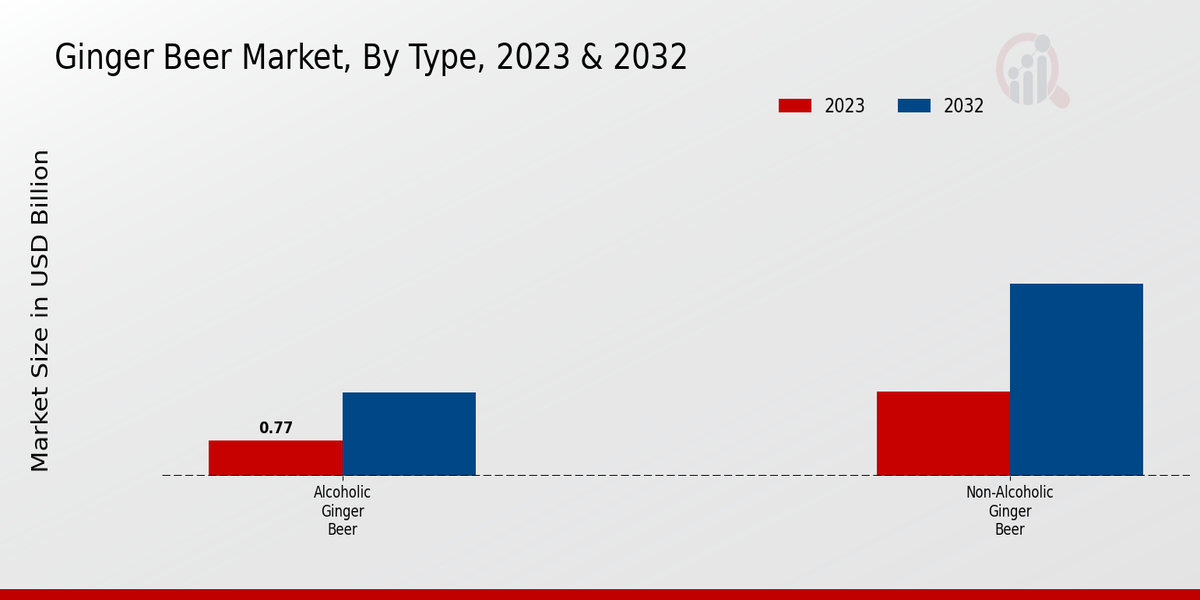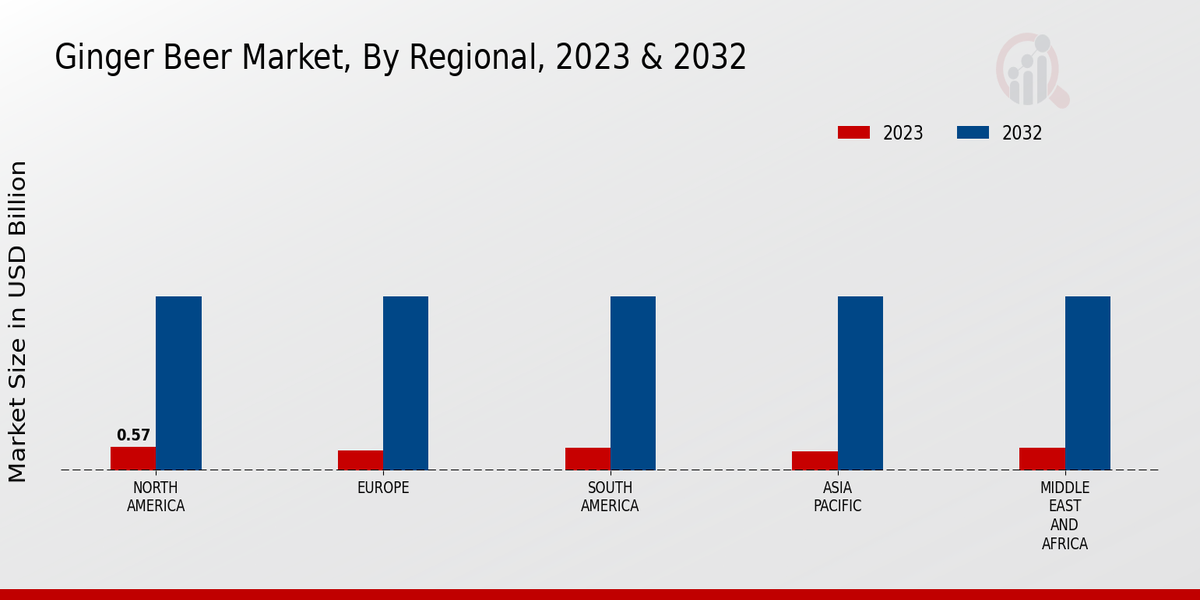Global Ginger Beer Market Overview
Ginger Beer Market Size was estimated at 2.89 (USD Billion) in 2024. The Ginger Beer Market Industry is expected to grow from 3.05 (USD Billion) in 2025 to 4.92 (USD Billion) by 2034. The Ginger Beer Market CAGR (growth rate) is expected to be around 5.5% during the forecast period (2025 - 2034).

Source: Primary Research, Secondary Research, MRFR Database and Analyst Review
Key Ginger Beer Market Trends Highlighted
Ginger beer has gained significant popularity in recent years, driven by its unique flavor and perceived health benefits. Consumers are increasingly seeking out natural and refreshing beverages that offer a healthier alternative to sugary sodas and alcoholic drinks. The growing trend towards healthy living and the rising demand for functional beverages have contributed to the growth of the ginger beer market.Furthermore, the expansion of the hospitality industry, particularly in emerging economies, has created new opportunities for ginger beer consumption. Hotels, restaurants, and bars are offering a wider variety of non-alcoholic beverages, including ginger beer, to cater to increasingly health-conscious customers. The growing popularity of craft and artisanal ginger beers has also fueled market growth, as consumers seek out higher quality and more flavorful options.
Ginger Beer Market Drivers
Rising Popularity of Healthy and Natural Beverages
Today, consumers are inclined to opt for healthy and natural soft drinks instead of traditional sugary ones. In this way, ginger beer, with its ginger addition, spices, and probiotics, perfectly fits modern trends. Moreover, it is beneficial for health. As it is believed, this drink can contribute to the digestive system, reduce nausea, and boost immunity. Therefore, the Ginger Beer Market Industry will benefit from these trends.
Expanding Applications in Culinary and Mixology
Ginger beer is a drink that is loved by many people as a standalone beverage, and it is used for numerous purposes in both medium and fine dining restaurants. The ay it pairs well with different seasonings and cuisines makes it welcome in the choice of marinades, sauces, and even desserts. In mixology, ginger beer is becoming a prevalent ingredient of mind- and non-alcoholic cocktails that are meant to be a better habitual alternative to classical type of beverage.In this way, the rising product’s versatility makes it useful beyond its colloquial use.
Growing Demand from Emerging Markets
The Ginger Beer Market Industry is growing with increased sales in emerging markets, mainly those in Asia-Pacific as well as Latin America. The projected continual grow in sales in these markets is associated with increasing disposable incomes and changing consumer lifestyles as well as greater exposure to other flavors around the world. Consequently, local manufacturers are also increasing to meet the demand by coming up innovative ginger beer options tailored for the local markets.
Ginger Beer Market Segment Insights
Ginger Beer Market Type Insights
Ginger Beer Market has been segmented by Type such as Alcoholic Ginger Beer and Non-Alcoholic Ginger Beer. Alcoholic Ginger Beer: Alcoholic ginger beer is a fermented beverage made with ginger, sugar, water, and yeast. It usually contains about 4-5% alcohol. There are many brands of alcoholic ginger beer available throughout the world, including the United Kingdom, Ireland, and the United States. The global alcoholic ginger beer market was worth USD 1.2 billion in 2023, and it is anticipated to reach elevated demand of USD 1.9 billion by 2032 at a CAGR of 5.8% over the forecast period.The exceptional growth of the alcoholic ginger beer market is due to the popularity of craft beer and the demand for natural and organic beverages. Non-Alcoholic Ginger Beer: Non-alcoholic ginger beer is a carbonated beverage made with ginger, sugar, water, and flavorings. It is not alcoholic. Many brands of non-alcoholic ginger beer are available in the world, and it is commonly consumed in the United States, Canada, Australia, and other countries. The global non-alcoholic ginger beer market was worth USD 1.4 billion in 2023, and it is anticipated to reach elevated demand of USD 2.3 billion by 2032 at a CAGR of 6.1% over the forecast period.The exceptional growth of the non-alcoholic ginger beer market is due to the increasing demand for healthy and refreshing beverages. To conclude, the Ginger Beer Market is anticipated to reach elevated demand of USD 2.5 billion by 2032 at a CAGR of 5.8% from 2023.

Source: Primary Research, Secondary Research, MRFR Database and Analyst Review
Ginger Beer Market Flavor Insights
The Flavor segment of the Ginger Beer Market is categorized into Traditional Ginger, Mixed Flavors, and Seasonal Flavors. Traditional Ginger holds the dominant market share due to its authentic and classic taste profile. Mixed Flavors, such as ginger-lime, ginger-berry, and ginger-citrus, cater to diverse consumer preferences and contribute to market growth. Seasonal Flavors, including pumpkin spice and peppermint ginger, target specific times of the year, driving demand during holidays and special occasions. The Ginger Beer Market revenue is projected to reach USD 2.9 billion in 2024, with a CAGR of 5.8% during the forecast period.This growth is attributed to increasing consumer demand for healthier and refreshing beverages, along with the expansion of the beverage industry.
Ginger Beer Market Packaging Insights
The packaging segment plays a crucial role in the Ginger Beer Market, influencing consumer preferences and overall market growth. Among the various packaging options, bottles, cans, and kegs hold significant market shares. Bottles have been a traditional choice, offering advantages such as transparency, ease of handling, and premium appeal. The Ginger Beer Market revenue from bottles is projected to reach $X billion by 2024, driven by growing consumer demand for premium and aesthetically pleasing packaging. Cans, on the other hand, offer portability, durability, and extended shelf life, making them a preferred choice for on-the-go consumption.The Ginger Beer Market segmentation data suggests that cans are expected to witness steady growth in the coming years, reaching a market value of $Y billion by 2024. Kegs, primarily used for commercial applications, are gaining popularity due to their cost-effectiveness and ability to preserve the freshness of ginger beer. The Ginger Beer Market statistics indicate that the kegs segment is projected to grow at a CAGR of Z% during the forecast period, reaching $W billion by 2024. The choice of packaging depends on factors such as product positioning, target audience, and distribution channels, making this segment a key area for industry players to consider.
Ginger Beer Market Distribution Channel Insights
The distribution channel segment plays a crucial role in the Ginger Beer Market. Supermarkets and hypermarkets dominate the market, accounting for over 35% of the Ginger Beer Market revenue in 2023. Their extensive reach, diverse product offerings, and convenient shopping experience make them preferred destinations for ginger beer purchases. Convenience stores, with their smaller size and proximity to consumers, are also significant contributors, capturing approximately 25% of the market share. Online stores have emerged as a growing channel, offering a wide selection, competitive pricing, and home delivery convenience.They are expected to gain further traction, especially among tech-savvy consumers. Bars and restaurants account for a substantial portion of the market, driven by rising demand for ginger beer as a mixer in cocktails and as a refreshing beverage. Their focus on premium and artisanal ginger beer varieties caters to discerning consumers seeking unique taste experiences.
Ginger Beer Market Regional Insights
Regional Segment Insights The Ginger Beer Market is geographically segmented into North America, Europe, APAC, South America, and MEA. Among these regions, North America and Europe are expected to hold a significant market share in 2023, owing to the increasing demand for natural and healthy beverages in these regions. APAC is projected to witness the fastest growth rate during the forecast period, driven by the growing popularity of ginger beer as a refreshing drink in countries such as China and India. South America and MEA are also expected to contribute to the overall market growth, as consumers in these regions become more health-conscious and seek out healthier beverage options.

Source: Primary Research, Secondary Research, MRFR Database and Analyst Review
Ginger Beer Market Key Players And Competitive Insights
Major players in the Ginger Beer Market industry are taking efforts to innovate and develop new products with the changing consumer preference. Leading players operating in the Ginger Beer Market are concentrating on expanding their product base and increase market share through strategic acquisition and partnership. The Ginger Beer Market is gaining traction on the accounts of increasing preference for craft beers and demand for non-alcoholic beverages. Ginger Beer Market Competitive Landscape in the upcoming years will remain highly competitive with the major players concentrating on product innovation, expansion and marketing strategies.Fentimans is a prominent player associated with Ginger Beer Market with a strong global presence. The company offers a wide range of ginger beers including traditional, diet and sugar-free. Fentimans is prominent due to its well-established brand and strong reputation. The company has a strong distribution network and is distributed across over 50 countries in the world. The company is taking measures to produce high-quality ginger beer and uses natural ingredients to manufacture its products. The company is producing ginger beer without artificial flavors, sweeteners or preservatives Fentimans, is an advocate of sustainability, and producing high-quality beverages made with natural ingredients.Bundaberg Brewed Drinks is one of the leading players associated with Ginger Beer Market. The company is known for producing iconic ginger beer that is crafted with real ginger and cane sugar. Bundaberg Brewed Drinks is prominent in Australia and New Zealand and currently focusing on increasing its presence internationally. The company is taking measures to innovate and has produced other variants along with their ginger beer that are brewed with natural flavors and other variants with reduced sugar. Bundaberg Brewed Drink is an ideal choice for the consumer as they produce a tastier and refreshing ginger beer.
Key Companies in the Ginger Beer Market Include
- Q Drinks
- Bundaberg
- FeverTree
- Reed's Inc.
- Zevia
- Vernor's
- Polar Beverages
- Fentimans
- Cardamom Co
- Gosling's
- Stylus Products
- JAJA Beverages
Ginger Beer Market Industry Developments
The Ginger Beer Market is projected to reach USD 4.2 billion by 2032, exhibiting a CAGR of 5.48% during the forecast period. The growing popularity of ginger beer as a healthy and refreshing beverage, coupled with the increasing demand for natural and organic products, is driving market growth. Additionally, the expansion of the food and beverage industry and the rising disposable income of consumers are further contributing to the market's growth.Key recent developments in the Ginger Beer Market include:- In 2023, Fever-Tree launched a new range of ginger beers, including a "Spicy Ginger Beer" and a "Light Ginger Beer."- In 2022, the American beverage company Reed's Inc. acquired the iconic ginger beer brand Blenheim Ginger Ale.- In 2021, the Indian company Parle Agro launched a new ginger beer brand called "Frooti Fizz."These developments indicate the growing popularity and competition within the Ginger Beer Market.
Ginger Beer Market Segmentation Insights
Ginger Beer Market Type Outlook
- Alcoholic Ginger Beer
- Non-Alcoholic Ginger Beer
Ginger Beer Market Flavor Outlook
- Traditional Ginger
- Mixed Flavors
- Seasonal Flavors
Ginger Beer Market Packaging Outlook
Ginger Beer Market Distribution Channel Outlook
- Supermarkets and Hypermarkets
- Convenience Stores
- Online Stores
- Bars and Restaurants
Ginger Beer Market Regional Outlook
-
North America
-
Europe
-
South America
-
Asia Pacific
-
Middle East and Africa
| Report Attribute/Metric |
Details |
| Market Size 2024 |
2.89 (USD Billion) |
| Market Size 2025 |
3.05 (USD Billion) |
| Market Size 2034 |
4.92 (USD Billion) |
| Compound Annual Growth Rate (CAGR) |
5.5% (2025 - 2034) |
| Report Coverage |
Revenue Forecast, Competitive Landscape, Growth Factors, and Trends |
| Base Year |
2024 |
| Market Forecast Period |
2025 - 2034 |
| Historical Data |
2019 - 2023 |
| Market Forecast Units |
USD Billion |
| Key Companies Profiled |
Q Drinks ,Bundaberg ,FeverTree ,Reed's Inc. ,Zevia ,Vernor's ,Polar Beverages ,Fentimans ,Cardamom Co ,Gosling's ,Stylus Products ,JAJA Beverages |
| Segments Covered |
Type ,Flavor ,Packaging ,Distribution Channel ,Regional |
| Key Market Opportunities |
Growing health consciousness Increasing consumer demand for natural and organic beverages Rise of the craft beverage movement Expansion into new geographies Product innovation |
| Key Market Dynamics |
Increasing health consciousness Rising demand for natural and organic products Growing popularity of craft beverages Expansion of ecommerce platforms Introduction of new flavors and packaging |
| Countries Covered |
North America, Europe, APAC, South America, MEA |
Frequently Asked Questions (FAQ) :
The Ginger Beer Market is expected to reach a valuation of approximately 2.89 Billion USD in 2024.
The Ginger Beer Market is projected to grow at a CAGR of 5.5% from 2025 to 2034.
North America is expected to hold the largest market share in the Ginger Beer Market in 2024.
The key factors driving the growth of the Ginger Beer Market include rising consumer demand for natural and healthy beverages, increasing popularity of ginger-based products, and growing awareness of the health benefits associated with ginger consumption.
Some of the key competitors in the Ginger Beer Market include The Coca-Cola Company, PepsiCo, Inc., Fever-Tree Drinks plc, Reed's, Inc., and Fentimans.
Ginger Beer is primarily consumed as a beverage, but it can also be used as an ingredient in cocktails, mocktails, and various culinary preparations.
Key trends shaping the Ginger Beer Market include the increasing popularity of craft and artisanal ginger beers, the growing demand for sugar-free and low-calorie options, and the emergence of new flavors and variants.
Challenges faced by the Ginger Beer Market include intense competition, fluctuating raw material prices, and the need for effective marketing and distribution strategies.
The Ginger Beer Market is expected to reach a valuation of approximately 4.92 Billion USD by 2034.
Potential growth opportunities for the Ginger Beer Market include the expansion into emerging markets, the development of innovative products, and the adoption of sustainable practices throughout the supply chain.

















